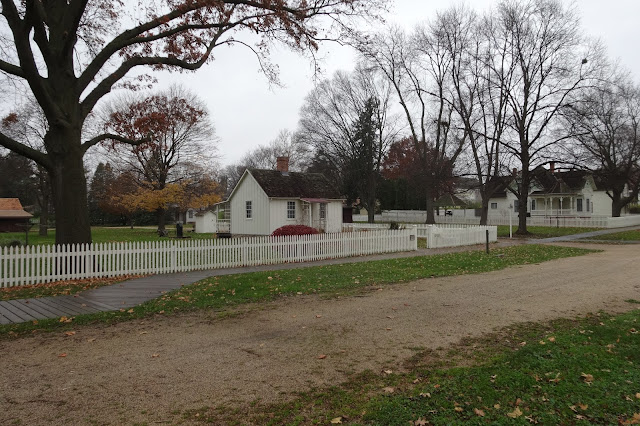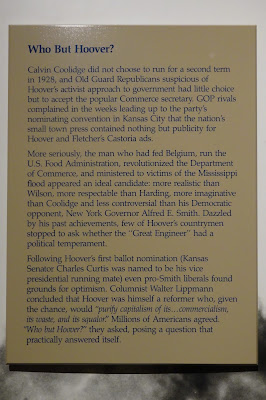 It was time for another Presidential Library and Museum. We drove all the way to Iowa to visit Herbert Hoover's. Having purchased Presidential passports for the Libraries and Museums, we are on a mission to see all 13 of them. Although we have visited quite a few additional ones, there are only 13 supported by the National Archives. After Hoover's, we only have 3 more (George W. Bush, Gerald Ford, and Franklin D. Roosevelt) to officially visit. However, we need to revisit 3 (Ronald Reagan, Richard Nixon, and John F. Kennedy) in order to get passport stamps. Our goal is to visit all 13 and any additional ones we can find, usually supported by family or foundations.
It was time for another Presidential Library and Museum. We drove all the way to Iowa to visit Herbert Hoover's. Having purchased Presidential passports for the Libraries and Museums, we are on a mission to see all 13 of them. Although we have visited quite a few additional ones, there are only 13 supported by the National Archives. After Hoover's, we only have 3 more (George W. Bush, Gerald Ford, and Franklin D. Roosevelt) to officially visit. However, we need to revisit 3 (Ronald Reagan, Richard Nixon, and John F. Kennedy) in order to get passport stamps. Our goal is to visit all 13 and any additional ones we can find, usually supported by family or foundations.We drove 15 miles into Davenport, IA. First, we went to the Herbert Hoover Presidential Library-Museum.
The first room we went into was themed "The Making of the Great Humanitarian: Herbert Hoover and World War I." The exhibit took visitors through the early days of the war, beginning with the Hoovers assisting stranded Americans safely home and ending with the Commission of Relief in Belgium that fed millions during the war.










We moved into the next area of the museum which covered the first 40 years of Herbert Hoover's life, including choosing a career and getting married. Robin especially liked the fact that Hoover chose to become a mining engineer.













Herbert Hoover had a big heart for children who were in need. He served as president of the American Child Health Association throughout the 1920s. In that role, he helped design the Child's Bill of Rights in 1923. Later, as 31st President of the United States, this document influenced other more comprehensive decisions for children.

In 1927, Herbert Hoover rushed to the aid of the people when the Mississippi River flooded. This picture illustrated Hoover's hands-on involvement and compassion for the people. His engineering problem solving skills took over finding solutions.


Herbert Hoover served as President of the United States from 1929 to 1933. Although he had some important accomplishments, he also had some very major events happen during his term.




The Hoovers enjoyed life in the White House although there were some tough times. They also went to Camp Rapidan for relaxation when able.

Herbert Hoover loved "His Lou." His wife, Lou Henry, was the love of his life. The museum had an area devoted to The First Lady. The tone was set with the following display, which has been retyped due to the inability to read.
"My Lou"

Born in Waterloo, Iowa in 1874, Lou Henry learned to love the outdoors from her father who "...would not want me to stay meekly at home." The day after her marriage to Herbert Hoover in February 1899, the newlyweds boarded a ship to China, the first in a series of global journeys that carried them to the farthest corners of civilization.
Lou was Bert's partner in nearly everything he did, from translating a German history of mining from Latin into English, to raising money for desperate Belgians during World War I. Among many of her own pursuits a First Lady, Lou Henry Hoover transformed the shabby White House into a showcase for American art and antiques. When the Great Depression cast a shadow over her husband's presidency, Lou privately channeled assistance to many victims of the hard times.
After the Hoovers' unsuccessful 1932 reelection campaign, Lou cheerfully persevered before suffering a heart attack in 1944. After her death, Herbert Hoover found scores of uncashed checks in her desk from young students, old friends, and utter strangers who had attempted to repay her generosity.
Lou was active with the Girl Scouts as well as the Red Cross.


Although President Hoover ran for reelection in 1932, he was defeated by Franklin D. Roosevelt. The Hoovers went back to their home in Palo Alto, California.
Life after the presidency was quiet, but not without opinions. Hoover was not happy with some of the policies President Roosevelt was making. The former president did get involved in writing books and also became Chairman of the Board of the Boys' Clubs of America.





This plaque was one of Robin's favorite of Hoover's awards. As a Professional Engineer, he used his problem solving skills to benefit of all humanity.
Hoover developed a friendship with President Truman. Although he didn't share some of the same political views, President Truman saw the value of the only former president still living. He sent Hoover on diplomatic tasks both at home and abroad. They became close and the relationship made Hoover feel useful and alive. President Truman restored the name of the Hoover Dam. During the Roosevelt presidency, the dam had been renamed Boulder Dam.


The Herbert Hoover Presidential Library-Museum was beautifully decorated for the holidays. The quote over the doorway said it all about what we had learned through our visit.
We shopped a little at the bookstore before leaving to explore the rest of the Hoover property. It was cold, windy, and dreary outside so we decided to drive to the Herbert Hoover National Historic Site. It was still on the main property.
Once inside, we watched the movie about Herbert Hoover growing up in West Branch, Iowa. Then we looked at the small exhibit area about his life.



From the Visitor Center, we bundled up and walked through the parking lot to go visit some of the historic buildings on the property. We stopped at the corner to view the map of the area and the memorial rock, honoring that he was the first President of the United States to be born west of the Mississippi River.
We went first to the Blacksmith Shop. Herbert's father, Jesse, had worked as a blacksmith. This shop, although a replication, was like the one where he had worked. It was rebuilt about a block west of its original location and was reconstructed from sketchings Herbert's older brother, Theodore, had drawn of his recollection of the original shop. Jesse later owned a farm implement store where he sold pumps, wagons, barbed wire, and sewing machines. He ran that store until 1880 when he died at the age of 34. At the Blacksmith Shop, we watched a volunteer make horseshoes. He educated us on the different kinds of shoes that were made from horses to cows to oxen. He talked about making the wooden wheels and the materials used. It was quite fascinating.


From the Blacksmith Shop, we crossed the street and went to Hoover's Birthplace Cottage. We started at the outhouse behind the house before going inside. Jesse built the two room cottage for his family. One room is where the adults and the 3 children (Theodore, Bert, and Mary) slept while the other room was a combination living room, dining room, and kitchen.











Finally, we made it to the car. While we warmed up a bit, we drove around the park to reach the Hoover grave sites. The drive was very scenic. We reached the parking area and then bundled up to walk to the graves.



It was a 215 mile drive to our hotel in Springfield so we knew we would be driving for a little over 3 hours. The weather was still overcast with some light rain as we went. We drove I-80 and saw more silos, then past the Iowa 80 Truckstop in Walcott, Iowa before stopping at McDonald's to pick up lunch. The wind was so strong at McDonald's.




We drove to the Crowne Plaza and checked in. We took our luggage up to our room and headed right back out to find some place for dinner Outback was a couple of blocks away so we decided we were okay with going for a "known" restaurant. We ate and headed right back to the room. It was the night we had planned to do laundry. However, Crowne Plaza does not have guest laundry available. They will do it for you at a cost. We decided we had enough clothes for the next day, so we would look for a laundromat in Springfield tomorrow.
After a little relaxation and computer time, we turned in and called it a night. It had been a long day and our brains had taken in so much information. We needed rest in order to absorb more information about President Lincoln in Springfield. Hopefully, the weather would be nicer with a little sunshine.

















































































































